Harry Withnall: Can I Please Have My Name Back?
Introduction and Identification
Having found myself emerging from the languid state fostered by my chest infection, I thought I would tackle one more Wyrley soldier story before I really felt up to running around record offices in the name of research. I chose an obvious candidate for another error, thinking it would be quite straight-forward; it actually wasn’t and nearly set my recovery back weeks! The story of Harry Withnall would leave me a little sadder than usual after writing these mini-biographies: not only because he turned out to be an only child, but also that both Great Wyrley and Cheslyn Hay’s memorials have his name incorrect – just in different ways.
Wyrley’s error seems as incongruous as having John Wilkes Booth carved next to Abraham Lincoln on Mount Rushmore. Whithnell, if accurate, is a very curious surname: and yes, you can take curious as to mean my personal suspicions that another spelling error had taken place. I went straight to my sources to corroborate the name and the Great Wyrley Wesleyan Chapel plaque duly came up with the name Harry Withnall, who is clearly the person represented by the Whithnell H on the gates.
I next checked the Staffordshire Roll of Honour: this was compiled in February 1926 by the Staffordshire War Memorials Committee and contains all the Staffordshire war memorials and the names upon them. The roll not only had a Withnall H, Private, South Staffordshire Regiment under the Great Wyrley entry, but also had exactly the same under the Cheslyn Hay entry – in short, Withnall was another soldier that appeared on both the Wyrley and Cheslyn Hay memorials.

The 1926 Staffordshire Roll of Honour for Gt Wyrley – showing a H Withnall of the South Staffordshire Regiment.
(Walsall Local History Centre)
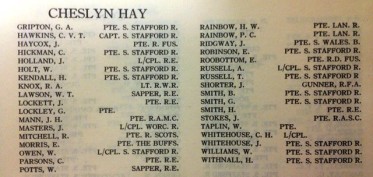
The 1926 Staffordshire Roll of Honour for Cheslyn Hay – showing a H Withnall of the South Staffordshire Regiment.
(Walsall Local History Centre)
Everything seemed to be going well: the Whithnell spelling on the Wyrley gates had been shown-up for the error it was, but the correct person had been identified and this would be presented to the Great Wyrley Parish Council at a later date in a hope to get the plaque changed. Then the unthinkable happened, a second error emerged. The Cheslyn Hay memorial had the correct spelling for Withnall, but the wrong christian name attached – they had him on the memorial as William Withnall. Harry as a name is problematical in that it is a name itself or a nickname for Harold or Henry for example, but surely it could not stretch to William could it?
It seemed to me that I needed to link Harry Withnall to both Great Wyrley and Cheslyn Hay if possible, but if I couldn’t then I would need to show that the William Withnall was an error in its own right. It took a while, but I think I managed get there in the end. My search for Harry took a somewhat irregular route, but in the interest of continuity I will present it chronologically…
Early Life: Charles Henry ‘Harry’ Withnall
Let it suffice to say at this stage that I knew Harry was 25 when he was killed on 2 August 1915, which would put a birth at the tail end of 1889 or the first half of 1890. As Harry may not be a definitive name and Withnall a rare one, I did a quick review of all birth certificates issued for Withnalls between 1889 and 1890. There was one Harry Withnall; he was born near Manchester in early 1889, but died the following year. The only other potential seemed to be a Charles Henry Withnall, who was born in the Lichfield area in early 1890. A bit of cross-referencing would prove that this was our Harry.
Charles Henry Withnall was the only child born to parents William and Mary Ann (nee Hough). The couple were married in Stafford in mid-1872. William was the son of a quarry man from Milford, near Stafford. In 1871 he had been working as a groom at Woodlands Hall, Uttoxeter; the Hall was owned by Robert Wood, a master brewer. Mary was the daughter of a shoemaker and from Penkridge. In 1871, she was living in Stafford and working as a boot fitter.
By 1881 the couple had been married nine years or so; William was around 31 at this stage, while Mary Anne was a few years older (in fact her age varies from census to census – all I can say for certain is that she was baptised in January 1849). They had settled in the West Cannock cottages, Hednesford, and William had now become a blacksmith. On the census for that year the couple were entertaining an Alice Hough, clearly a relative of Mary Anne’s.
The couple are living in the same buildings 10 years later only they have been joined by their only child, Charles Henry – that is Harry, who was around a year old. William was still a blacksmith. Harry’s casualty record has his birthplace as Rugeley, the census has it at Hednesford: in fact both are right – the cottages were a part the Hednesford area, within the Rugeley Civil Parish. Clearly another relative, a Mary Alice Hough, was employed as domestic help.
By 1901 the family had moved to the Brindley Heath area, which isn’t too far from their previous home. William, now in his fifties, is still a blacksmith in one of the local collieries or furnaces. Charles is 11 years-old and although it isn’t ascribed, it is safe to think that he is at school. The household has a lodger, Edwin Riley, who is a plate-layer and William’s 20 year-old nephew. A decade later and the family were still residing at the same address. The 1911 census is the first to link Charles Henry to ‘Harry’, as this is how he appears on this record. William, now 61 years of age, is still a blacksmith but now at least we know that he is employed in a colliery. Harry is described as a coal miner – loader, which could have been above or below ground.
It isn’t clear as to when the Withnall family moved over to the Great Wyrley and Cheslyn Hay area, but we do know that they are here by 1914. On the 30 January 1915 the Walsall Observer carried a small article in its column on Cheslyn Hay news; this article was about an appearance at the Cannock Police Court by a certain blacksmith named William Withnall. It appears that on 4 January 1915, a PC Shelton received a complaint regarding the ‘conduct’ of William Withnall; when he approached his house to speak to him on the issue (sadly, address not given), he ‘heard him make use of very bad language’. Withnall’s language was likely not improved by the guilty verdict and the order to pay 7s costs.
Harry’s Game
Harry has no surviving war record, so the basic framework is all we have to tell of his personal experiences. Harry attested into the 1/5th Battalion, South Staffordshire Regiment (formerly just the 5th Battalion): this was a Territorial Force battalion, so we know that either Harry was a active Territorial before the War started, a former Territorial, or he enlisted just prior to or as hostilities commenced. Whatever, he would have been called-up immediately and following a brief period in the Walsall area, the Battalion moved down first to Luton, where Harry would have signed-on for foreign service (Territorials were originally for home service) and then on, arriving in the Bishop’s Stortford/Saffron Waldon area in the middle of November 1914. Harry and the rest of the 1/5th Battalion would see the remainder of the year out here, undertaking intensive training and being in a position to help protect the south from the remote possibility of a German invasion. Make no mistake, Harry was on active service.
The new year would allow a couple of further months to get the 1/5th Battalion up to full strength, allow for further training, organise supplies and weapons etc. By the end of February, the Battalion knew it would be one of the first Territorial forces to go to France. The Battalion, as a part of the 137 (Staffordshire) Brigade of the 46th (North Midland) Divsion, would embark at Southampton and land at Le Havre, France on 5 March 1915. Harry’s medal card would record that he was with them.
It wouldn’t take long for Harry to be on the move. It is likely they took the same route as the 1/6th Battalion and went by train (well, cattle trucks) to Noordpeene and then by march, via Merris, to the Armentieres region. They remained here for a while, then Harry and the Battalion headed into Belgium; more precisely to the Messines sector, which was just south of the town of Ypres and its vulnerable salient.
Around 1 April 1915, Harry found himself at Wulverghem, a village opposite the Messines Ridge one that the Germans had captured the previous year. He would alternate, seemingly four days in the front-line trench and then four days at the ‘Bulford Camp’ where, if like anywhere else, the alleged rest was interrupted by fatigues and going on working-parties. Saying that, the sector was considered ‘quiet’ and the official war history of the 6th Battalion made it clear that ‘we knew from the start that we could, and should, do worse than this’. This was especially true considering that from 22 April until 25 May 1915 the Second Battle of Ypres was raging just to the north of their position, with the Germans attacking the British and French lines and making use of poison gas on the Western Front for the first time.
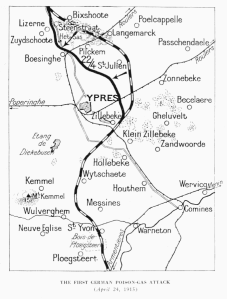
The Ypres salient and the villages of Wulverghem and Messines, when Harry was present in early 1915.
(Project Gutenberg)
To Harry and the 1/5th Battalion, the hostilities at Ypres were just noise. It is difficult to know how they felt, happy at avoiding the carnage or somehow frustrated that they were not part of it. It wouldn’t be until that battle had faded before Harry would find himself on the move, ironically to the very area that had seen a month’s bitter fighting. Harry’s Brigade was pulled out of the Messines area around 25 June and relocated within the salient. They found themselves in the Zillebeke/Ouderdom area, famed for Sanctuary Wood and Hill 60 (which had witnessed 3 weeks of fighting in April/May).
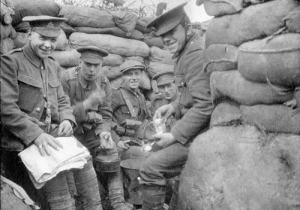
1/6th Staffords (part of Harry’s Brigade) at Hill 60 in 1915. (Staffordshire Regimental Museum / Staffordshire Record Office)
This sector was clearly livelier, as the History of the 1/6th Battalion pointed out with ‘both we and the Germans have dropped all thoughts of a quiet life in these parts’. Things were pretty snug, too; some of the front-line trenches were just 25 yards apart. Probably, like the 1/6th Battalion, the July for Harry and the 1/5th seemed to taken up with ‘strenuous efforts by day and night, over every portion of the sector to improve the defences’, which attracted constant, if not heavy, shell-fire.
Harry was killed on 2 August 1915. All we know is that he was killed in action, possibly from shell-fire as his body was not recovered. We know that his effects and his 1915 Star, British War Medal and his Victory Medal were sent to William, his father. I am fairly confident that William passed away in 1931, less so that Mary died in 1919.
Harry is one of over 54,000 names represented on the Ypres Memorial – otherwise known as the Menin Gate. Harry’s Commonwealth War Graves entry shows him as being the son of William and from 132 Station Street, Cheslyn Hay. Ironically, the only William Withnall killed in the War is directly below him on the Menin Gate – it shows that he was from Dorset and so adding more evidence that the ‘William’ on the Cheslyn Hay memorial is in fact Charles Henry ‘Harry’ Withnall.
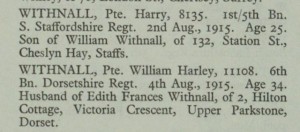
Harry’s CWGC entry, showing he was from Cheslyn Hay and the son of William. Ironically, the only William Withnall killed in the War is below.
(Commonwealth War Graves Commission)
So, I can tie Harry firmly to Cheslyn Hay. It is possible that the error on the memorial arose from somehow taking Harry’s father’s name, but for whatever reason, an error it is. I cannot trace Harry as living in Great Wyrley, even with the boundaries of the day, but he may well have worked there (in one of the collieries) and he does appear on the Great Wyrley Wesleyan Methodist plaque – which suggests that he attended the chapel. Again, what qualifies him for the Wyrley gates remains a moot point, but it is clear the spelling is somewhat awry.
I believe I have shown adequate evidence that both memorials are wrong, so I ask, can he have his name back please?
In Memory of Harry Withnall, and his parents William and Mary Anne – who lost their only child.
With Thanks to:
Cannock Library
National Archives
Walsall Local History Centre
Staffordshire Regimental Museum
Staffordshire Record Office
Project Gutenberg
Commonwealth War Graves Commission
Colonel W Vale: The History of the South Staffordshire Regiment, Gale & Polden Ltd, 1969
Committee of Officers and Men of the 6th Battalion: The War History of the 6th Battalion, South Staffordshire Regiment, William Heinemann Ltd, 1924.
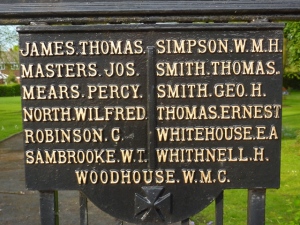
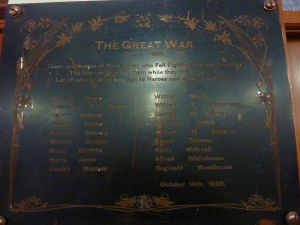
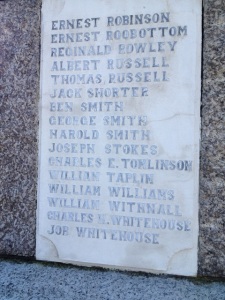
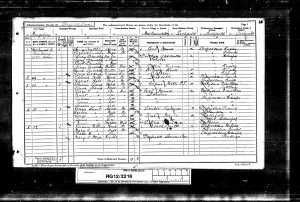
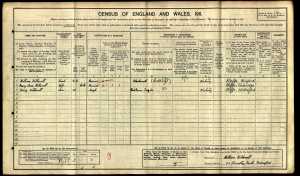
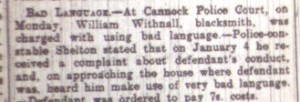
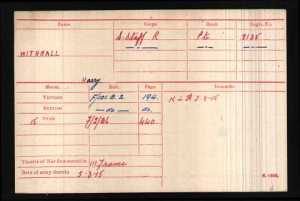
[…] Harry Withnall: Can I Please Have My Name Back? […]
I enjoy all of your investigations but found this one particularly touching as he seemed to have no recorded information of his own – even his father’s name was recorded instead of his. I know you must enjoy the investigative side as it is reflected in your writing, I just wanted to let you know that you bring a lot of pleasure to other people too.
Thank you, your comment means a lot
Yes, I have to agree with Yvonne, I’ve been researching my grandad’s war who was also in the 1/5th battalion at some point so I have enjoyed Harry’s story. You have the knack of putting meat on the bones when you tell their stories, making them real people instead of just names and numbers! Looking forward to the next one 🙂
Thank you, i just want people to remember them for being people and not just wrongly spelt names on a plaque
A good and remarkable story, your doing justice to our war memorial gates, so sad though for relatives. SJ
Morning Paul
From my enquiries I believe he was attached to the Royal Engineers Tunnelers.
As you are aware, the 1/5th WD, unlike most, names names and the diary for this day records,
The War Diary records,
“2 August 1915 – Mine explosion heard in the vicinity of St. Eloi. Enemy trench mortared 37. Rifle fire much heavier than usual before daylight. Enemy working party observed in same position as yesterday, was dispersed by 3rd Staffs Battery. Between 9.20 and 10am enemy shrapnelled 35, 36 and support trenches. Parapet damaged in three places.
8768 Pte J. Field killed.
Relieved by 6th North Staffs at about 10.30pm.”
Whilst Pte. Field is named, Harry is not. In fact, he is not named in the diary at all.
I have no visible evidence for this, however he was a coal miner and the battalion did supply many men to the Tunnelers.
Regards,
Graeme
That is interesting, Graeme. If i remember, when doing some of the tunneler soldiers, March 1915 (when Harry landed) is when they started pulling some of the tunneler units together. There is something out there that will answer the question, it is just finding it!